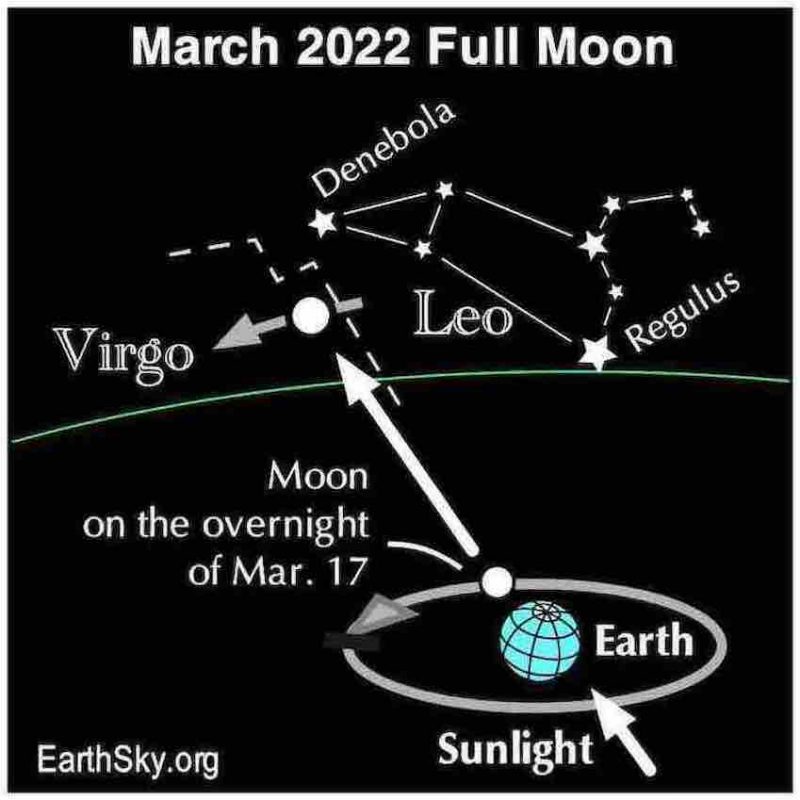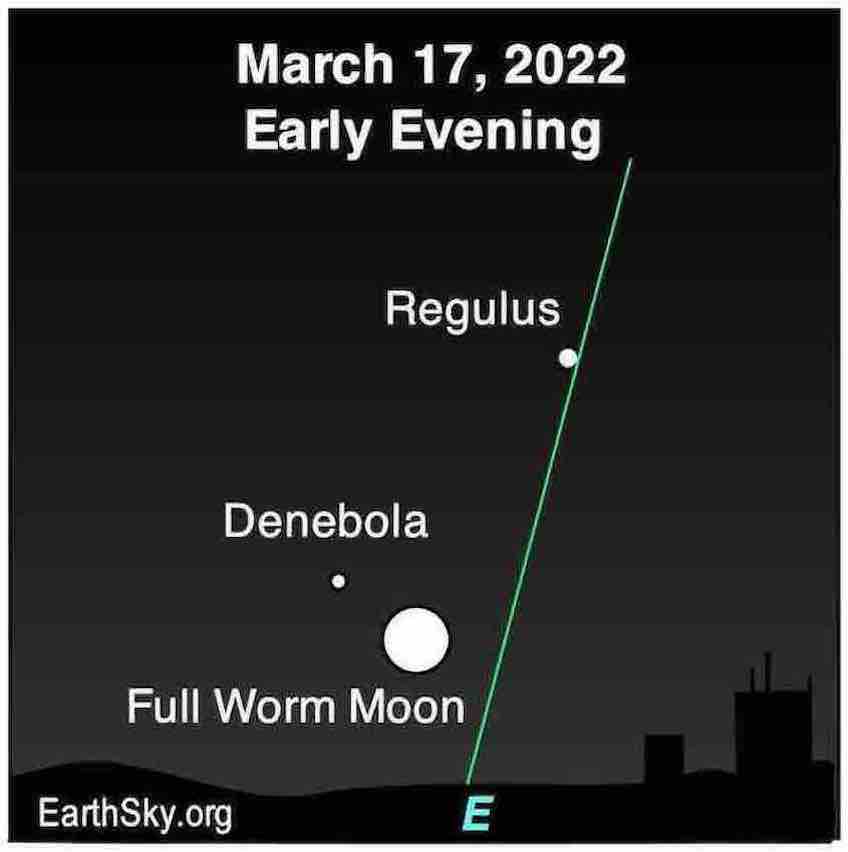
March full moon
The moon reaches the crest of its full phase at 07:18 UTC on March 18, 2022. That’s 2:18 a.m. CDT in central North America (translate UTC to your time). We’ll all see a round, bright, full-looking moon in our skies on both March 17 and 18.
The March full moon always appears among the stars of eastern Leo or western Virgo. That’s why every March full moon is near the star Denebola, the Lion’s Tail, in our sky. More about that below.
Keep reading to learn more features of the March full moon.
It’s the opposite of a Harvest Moon
The March 17-18 full moon is the closest full moon to 2022’s March equinox, which will fall at 9:37 UTC on March 20. It’s the spring equinox for the Northern Hemisphere. And it’s the autumn equinox for the Southern Hemisphere.
So for us in the Northern Hemisphere, the March full moon shows characteristics opposite those of a Harvest Moon. Meanwhile, this is the Southern Hemisphere’s Harvest Moon, famous for ushering in a succession of moonlit nights in the season of waning daylight.
Harvest Moon characteristics. In order to appear full to us, the moon must be opposite the sun in our sky. We see all of the moon’s day side. So the moon appears to us as completely lit: a bright, round, silvery orb. So all full moons rise at or around sunset. And – and because the moon moves eastward in orbit – with each passing day, the moon rises an average of 50 minutes later. Around the time of the Harvest Moon, though, the lag time between successive moonrises is reduced to a yearly minimum. For instance, at and around 40 degrees south latitude right now, the moon is rising only about 30 to 35 minutes (instead of 50 minutes) later daily. The short time between successive moonrises continues for several days around the Harvest Moon, giving the impression of a parade of moonlit nights in early evening every autumn.
March full moon characteristics. Meanwhile, in the Northern Hemisphere, this March full moon is the closest full moon to the spring equinox. So the lag time between successive moonrises reaches a yearly maximum. For instance, at 40 degrees north latitude, the moon is now rising some 75 minutes (rather than 50 minutes) later each day. If you’re in the Northern Hemisphere, notice the time of your moonrise tonight. And then notice how much later tomorrow night’s moon will rise.
The arc of the March full moon
And it’s not just moonrise times. It’s also the height of the moon’s arc across our sky that varies from month to month, and season to season. Every full moon rises in the east, as the sun sets in the west. Every full moon arcs across the sky throughout the night, and sets around dawn. For us in the Northern Hemisphere, the arc of this March full moon is lower than the paths of the full moons of December, January and February.
For those in the Southern Hemisphere, the full moon’s arc across the sky is climbing higher with each successive month, and will continue to do so until around the June solstice.
Before the advent of artificial lighting, our ancestors must have been well aware of these seasonal vagaries of our wayward moon.
March full moon near star Denebola
No matter where you are on Earth – depending on exactly when you look at it – this March full moon, and the full moons of every March, always appear among the stars of eastern Leo or western Virgo. The March 17-18, 2022, full moon is in the direction of the constellation Virgo for us in the Americas. It glows near Leo’s star Denebola, in the Tail of the Lion. Denebola is the western member of the asterism called the Spring Triangle. And the moon isn’t far from Regulus, Leo’s brightest star, as shown on the chart below.

March full moon is the Worm Moon
All the full moons have names. Popular names for the March full moon are Worm Moon, Crow Moon and Sap Moon. The name Worm Moon honors the stirring of earthworms and insect larvae in the slowly warming late winter and early spring soil.
Read: Full moon names by month and by season
March full moons sometimes set the date of Easter
… But not this year. Another common name for the March full moon is Lenten Moon. But this name is used most commonly for a full moon after the March equinox, on the 20th. The 2021 March full moon was on the 28th. So it was a Lenten Moon.
The Lenten Moon, or full moon following the March equinox, sets the date of Easter Sunday.
Read: When is Easter in 2022? And how is Easter tied to the night sky?

Bottom line: We in the Americas will see the moon as most full on the night of March 17-18, 2022.
The post March full moon on 17-18: Opposite a Harvest Moon first appeared on EarthSky.
0 Commentaires